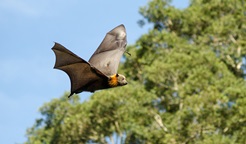Hunter Wetlands National Park
Learn more
Learn more about why this park is special
Hunter Wetlands National Park is a special place. Here are just some of the reasons why:
World-class wetlands

Hunter Wetlands National Park makes up part of the Hunter Estuary Wetlands Ramsar site (the Ramsar convention recognises wetlands of international importance). This peaceful area is important for many species of birds, including 45 that migrate internationally. The green and golden bell frogs, both threatened species, breed in the freshwater lagoons. The mangroves here also provide maternity roosts for tiny bats, including the eastern free-tail bat.
- Junior ranger: Shorebirds and mangroves Calling all junior rangers, join us on a birdwatching adventure these school holidays! Bring your camera and see if you can photograph the shorebirds at Hunter Wetlands National Park, near Newcastle.
- Rainforest walk to Riverside Park Rainforest walk to Riverside Park, near Newcastle, is suitable for walking or cycling and crosses Ash Island, ending by the river where you can fish and birdwatch.
- Riverside Park The family-friendly Riverside Park, near Newcastle, is the perfect base for cycling, walking, fishing and birdwatching on Ash Island.
Feather bluster

The Hunter River and its estuaries are home to a number of habitats - freshwater wetlands, mangroves and coastal rainforest among them - making the area a haven for birdlife. More than 200 species of birds live here or pass through on their migration. Head to Stockton Sandspit, where shorebirds - plovers, oystercatchers and curlews, to name a few - roost and feed on the mud flats. Along the river foreshore, you'll also likely see pelicans, spoonbills, black swans and, sweeping over the water searching for fish, sea eagles and swamp harriers.
- Guided kayak adventures at Smiths Island Spend a day exploring mangrove forests and islands by kayak on this tour of Hunter Wetlands National Park with the friendly guides from the School of Yak. It’s a great way to reconnect with nature in ...
- Junior ranger: Shorebirds and mangroves Calling all junior rangers, join us on a birdwatching adventure these school holidays! Bring your camera and see if you can photograph the shorebirds at Hunter Wetlands National Park, near Newcastle.
- The Earth's environment Did you know that over 10 per cent of NSW is a national park? That’s over 7 million hectares. This Stage 2 (Years 3-4) Geography excursion is delivered Hunter Wetlands National Park.
Early evidence

Get a taste of some of the area's history. From the picnic area at Riverside Park, you can walk through the Kooragang City Farm precinct and find the ruins of the farmhouse and dairy built by William Milham, who ran a property here with the first European owner of Ash Island, AW Scott. Also on the island is a heritage-listed World War II radar 'igloo'.
- Rainforest walk to Riverside Park Rainforest walk to Riverside Park, near Newcastle, is suitable for walking or cycling and crosses Ash Island, ending by the river where you can fish and birdwatch.
- Scotts Point Way to Riverside Park trail Enjoy an easy walk or bike ride along the river on the Scott Point to Riverside Park trail, Ash Island, as it takes you past excellent spots for fishing and birdwatching.
All-ages adventure

The action all starts at Riverside Park. Here, you'll find a picnic area and paths leading off around Ash Island. They're all flat and wide, so perfect for getting kids on their bikes for some fresh air. Take a walk through the wetlands and identify different species of birds. Head to the deepwater jetty and do some fishing. There's quite the underwater bounty around here and, whether your spot is the jetty or the river foreshores, you can haul in flathead, whiting, tailor and bream.
- Rainforest walk to Riverside Park Rainforest walk to Riverside Park, near Newcastle, is suitable for walking or cycling and crosses Ash Island, ending by the river where you can fish and birdwatch.
- Riverside Park The family-friendly Riverside Park, near Newcastle, is the perfect base for cycling, walking, fishing and birdwatching on Ash Island.
- Scotts Point Way to Riverside Park trail Enjoy an easy walk or bike ride along the river on the Scott Point to Riverside Park trail, Ash Island, as it takes you past excellent spots for fishing and birdwatching.
Plants and animals protected in this park
Animals
-

Grey-headed flying-fox (Pteropus poliocephalus)
The grey-headed flying fox is Australia's largest native bat, with a wingspan up to 1m. This threatened species travels up and down south-eastern Australia and plays a vital role in pollinating plants and spreading seeds in our native forests.
-

Green and golden bell frog (Litoria aurea)
The green and golden bell frog is an endangered Australian frog. Once common on the NSW coast and tablelands, populations have plummeted around 90 percent.
Plants
-

Grey mangrove (Avicennia marina)
Grey mangrove is the most common and widespread mangrove found within intertidal zones across Australia, and throughout the world. Growing to a height of 3-10m, they thrive best in estuaries with a mix of fresh and salt water. They excrete excess salt through their long thick leaves, and absorb oxygen through their aerial root system.
Look out for...
Grey-headed flying-fox
Pteropus poliocephalus

The grey-headed flying fox is Australia's largest native bat, with a wingspan up to 1m. This threatened species travels up and down south-eastern Australia and plays a vital role in pollinating plants and spreading seeds in our native forests.
Education resources (1)
School excursions (2)
- Aboriginal culture, Stage 2 (Years 3-4), Geography
- The Earth's environment, Stage 2 (Years 3-4), Geography
